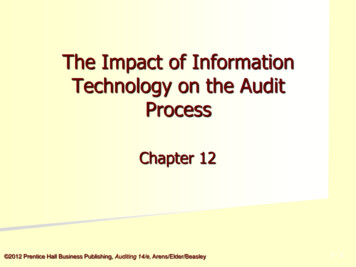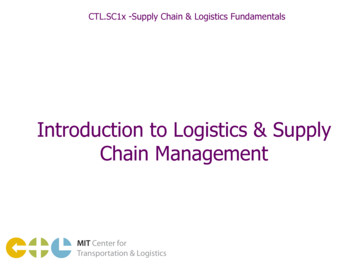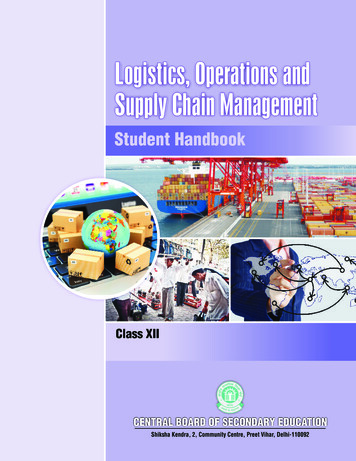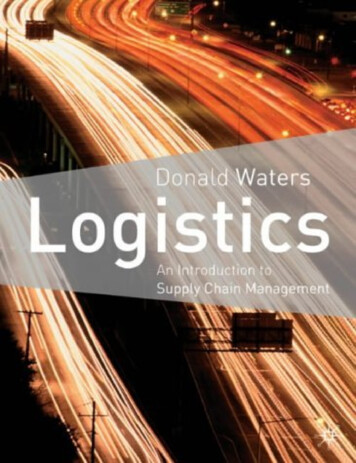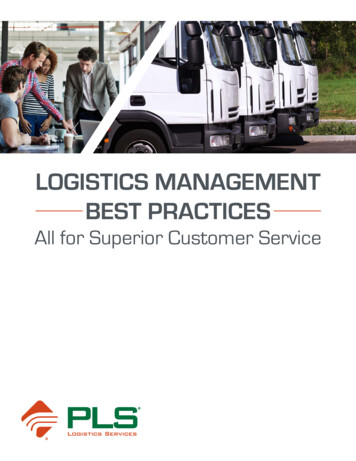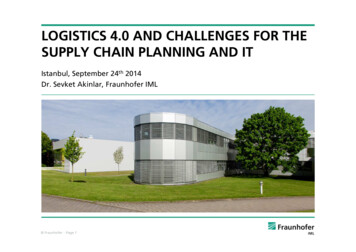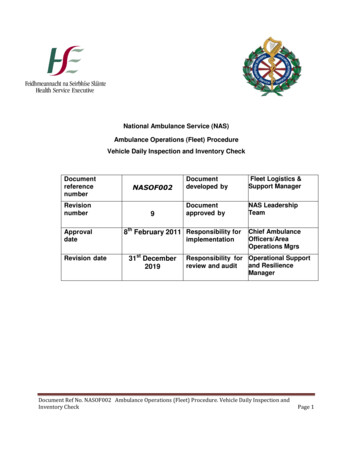
Transcription
IOSR Journal of Business and Management (IOSR-JBM)e-ISSN: 2278-487X, p-ISSN: 2319-7668PP 19-24www.iosrjournals.orgImpact of Technology on Logistics and Supply ChainManagementRajiv BhandariF-303, Arenja Complex, Sector 8, C.B.D Belapur Navi Mumbai 400614, 9819884293Email – rajiv sies@yahoo.co.inAbstract:- The word logistics has its origin from Greek word “logistike” which means the art of calculating.However, the modern interpretation of the term logistics has its origin in the military, where it was used todescribe the activities related to the procurement of ammunitions, and essential supplies for troops located at thefront. Logistics not only includes activities related to the physical movements of the goods but also managesrelationship with suppliers and customers. However Logistic management is a means whereby the needs ofcustomers are satisfied through integration and coordination of the supply chain. The main objective of thepaper is to determine the various technology used in logistics and supply chain management includinginformation technology, communication technology and automatic identification technology. The paperalso discusses the impact of the technology on logistics and supply chain management. The author mainlyfocuses on the secondary data for collecting data relating to various technology used in logistics and supplychain management. The author draws conclusion that Technology is a vehicle to enhance supply chaincompetitiveness and performance by enhancing the overall effectiveness and efficiency of logistics system.Moreover various innovations in technology have made the task easier and faster besides being less laborious.I.INTRODUCTIONThe council of logistic management defines logistics as “that part of supply chain process that plans,implements, and controls the efficient, effective, forward and reverse flow and storage of goods, services, andrelated information between the point of origin and the point of consumption in order to meet customerrequirement”. In ordinary language the same can be defined as right product, at the right place, in right time,and in right condition. However supply chain consists of all stages that are required to satisfy the customerrequest. It starts from supplier passes through manufacturer, distribution, retailer and finally reaches thecustomer. The supply chain management is the oversight of materials, information and finances as they move inthe process from supplier to manufacturer to wholesaler to retailer to customer.The emerging new technologies are creating strategic opportunities for the organizations to buildcompetitive advantages in various functional areas of management including logistics and supply chainmanagement. However the degree of success depends on the selection of the right technology for theapplication, availability of proper organizational infrastructure, culture and management policies. In logistics,information, communication and automation technologies has substantially increased speed of identification,data gathering, processing, analysis and transmission, with high level of accuracy and reliability. Technology isa means to enhance business competitiveness and performance. It plays a major role in success of supply chainby enhancing the overall effectiveness and efficiency of the logistics system. In logistics many new technologiesare used in developed country while in India adoption process is very slow. However due to liberalization of theIndian economy the competitive pressure is building up and the only option to face the competition in to go infor technology enabled operations.The latest technologies being used in logistics and supply chain management are segregated into Automatic Identification Technology Communication Technology Information TechnologyII. OBJECTIVESTo determine the various technology used in logistics and supply chain management.To discusses the impact of technology on logistics and supply chain management.7th International Business Research ConferenceIndian Education Society's Management College and Research Centre19 Page
IOSR Journal of Business and Management (IOSR-JBM)e-ISSN: 2278-487X, p-ISSN: 2319-7668PP 19-24www.iosrjournals.orgAutomatic Identification TechnologyAutomatic Identification (Auto ID) is the term used to describe the direct entry of data or informationin the computer system, programmable logic controllers or any microprocessor-controlled device withoutoperating a keyboard. These technologies include Bar Coding, Radio Frequency Identification (RFID) andVoice Recognition. Auto ID can be used for tracking the containers, packages, cartons or a truck carrying thegoods on time bound dispatches to the customers. The benefits of Auto ID include accuracy, cost saving, speedand convenience of data storage and processing of information.The significant Automatic Identification technologies in use are – Bar coding – Bar coding is a sequence of parallel lines of different thickness with spaces in between.These bars are nothing but the items of information in the codified form, which can be read with the helpof a scanner. Historically bar codes was first used in a supermarkets in USA in 1952.The informationprinted in bar code include, country code, manufacturer name, product details, date of manufacture,material content etc.These details are required at user end for inventory management. The bar codes areused in diverse industries such as retail, pharmaceutical, consumer goods, electronics, automobiles etc.The bar coding offers the following advantages. Ease in identification of inventory items during storage, retrival, pickup, inspection and dispatch. Reduce paper work and processing time leading Reduce human error Increases logistics system productivity through speed, accuracy and reliability.Impact of Bar code technology on operations of logistics and supply chain management Procurement operation – The parts and components brought from suppliers are assigned bar codes,which contain information on item name, batch number, date of manufacture, order no, serial no etc. Theinformation in bar code helps in identifying and tracking the component. In the warehouse, when thegoods enter through a conveyor, they are further scanned by the hand held scanner or scanner fixedalongside the conveyor. The information decoded by the scanner is immediately logged in the centralcomputer which helps real time update of inventory records. Processing – During the order processing the bar code will help in keeping identification of items basedon their date of entry into the warehouse or store. This will ease material storage, retrival and dispatch inFIFO (First in First out) inventory management system. Production operation – During the production process the identification of in-process and finished itemsbecome easier due to bar coding. The various bathes at different stages of production can be easilytracked. Distribution operation – During distribution, barcode helps in identifying and tracking the transit offinished goods to the customers.BARCODE Radio Frequency Identification (RFID) – RFID is an Automatic Identification and Data Capture(AIDC) technology. RFID first appeared in tracking and access applications during 1980. RFID-basedsystems allows for non contact reading and are effective in manufacturing and other hostileenvironment where bar codes could not survive. These are used as an alternative to Barcodes tocommunicate the inventory data to the reader via radio waves. RFID wirelessly exchanges informationbetween a tagged object and a reader.7th International Business Research ConferenceIndian Education Society's Management College and Research Centre20 Page
IOSR Journal of Business and Management (IOSR-JBM)e-ISSN: 2278-487X, p-ISSN: 2319-7668PP 19-24www.iosrjournals.orgAn RFID system is compromised of the following components as mentioned below. One or more tags called Radio Frequency Tags (RFTs), which includes a semiconductor chipand antenna. One or more read/write devices also called readers. Two or more antennas one on the tag and one on the reader. Application software and the host computer system.RFTsThe reader is connected to the central computer. Radio Frequency Tags (RFTs) are a piece of siliconchip to store data in the microcircuit. The RFTs are programmable with erasable memory. Data is stored incoded form and communicated to the reader through waves. The basic principle of tag is that antenna emits theradio signals.RFTs are very useful to accompany truck shipments. The tag will contain information onconsignor, consignee, inventory items, quantity and value, what time the item travelled certain zone; even thetemperature etc.The reader receives the tag signal with its antenna, decodes it and transfers the data to the hostcomputer system. RFTs can be attactched to virtually anything-from a semi tractor, to a pallet, containers etc.RFTs will avoid paperwork and can be helpful in quick clearance at octroi and custom posts. In the warehouse,the barcodes can be applied to the individual inventory items while RFTs can be applied to pallets, containersetc.These will allow the staff to directly communicate to the warehouse computer.RFID has significant impact on logistics and supply chain of many sectors RFID helps Indian exporters to global retailers like WAL-MART get better and more visibility intomovement of their goods within the supply chain and thus become more competitive. Improve the ability of manufacturers to better manage the inventory levels. Improve the complex distribution system for the Defense operation. Improve the complex tracking and distribution operations of the Indian Postal services. Improve the tracking, logistics and planning operations of Indian Railways, state public transportagencies Implement automatic toll collection on vast network of highways.Case study of RFID Technology Procter & Gamble(P&G) CompanyBefore – P&G used bar codes to track shipments of goods from factory to retail outlets, but couldn’t domuch to halt the supply shortages on store shelves.After – P&G used RFID is tracking shipments, and eventually individual products, so that they can bestocked on demand in stores. P&G expects to cut its costs by 400 million a year. Ford Motor CompanyBefore – Assembly-line workers running low on parts would have to pick up a phone and call thereplenishment department to get more parts and then wait for parts.After – Ford puts RFID tags on each parts bin. Warehouse operators now know in seconds, whensupplies run low, and automatically deliver parts as needed to workers on the assembly line. Voice Interactive System – This technology was developed in 1980.It is used in the field like medical,manufacturing, warehousing etc. In warehouse application; it allows the worker or operator tocommunicate the data to central computer without using the keyboard. It keeps the warehouse workershands free to pickup, pack and inspect the goods. He can read the part /item number while driving theforklift or picking the inventory and move from one pallet to other pallet. Due to online data transmissionto central computer there will be real time data updating.III.COMMUNICATION TECHNOLOGYThe communication, either oral or written has a very crucial role in business success. The following arethe few emerging communications technologies, which are enablers to superior customer service leading tocompetitiveness through the speed and accuracy in communication.7th International Business Research ConferenceIndian Education Society's Management College and Research Centre21 Page
IOSR Journal of Business and Management (IOSR-JBM)e-ISSN: 2278-487X, p-ISSN: 2319-7668PP 19-24www.iosrjournals.org Electronic Data Interchange (EDI) - EDI technology is used for transfer of business documents fromone computer to other computer. With EDI the business documents such as invoices, cheques, andchallans are sent electronically from one organization to another. In fact EDI is a drive towards paperlessdocument transfer or transactions. The difference between the email message and EDI message is that, Email is composed and interpreted manually, while EDI message is composed using one software andinterpreted by other software. E-mail data is not structured while EDI data or message is structured.EDImessage has legal standing in the court of law.The benefits of using EDI technology in logistics and supply chain management involvesFaster transactions- real time document transfer in the supply chain.Just-in-Time manufacturing technique can be adopted.Reduction in transaction cost due to paperless operationsReduction in order cycle time and inventory that will help to improve the competitiveness of thecustomers.Improve the corporate trading relationships between parties in the supply chain and creating barriers forcompetitors. Very Small Aperture Terminal (VSAT) - The satellite communication channels are playing a crucialrole in real time data collection and its exchange, which is vital for customer service. To trace and trackthe goods carrier, a dish antenna is fixed on the vehicle. This allows the communication between driver,consignor and consignee. The real – time interaction helps in having the up-to-date information on thelocation of truck and the delivery position.Example. – Wal-Mart the retail giant of USA is using this system for controlling the inventorymovement. Geographical positioning System (GPS) – The GPS is more accurate system used in developedcountries wherein a vehicle could be traced accurately with the help of Geo Stationary Satellites to theaccuracy of one meter in terms of latitude and longitude. Once the position of the vehicle is known, it canbe transmitted to consigner or consignee through the transmission network i.e. mobile phones or internet. Geographical Information System (GIS) – GIS are the software tools for visualization of speciallocation of any entity on earth which is st
The benefits of using EDI technology in logistics and supply chain management involves Faster transactions- real time document transfer in the supply chain. Just-in-Time manufacturing technique can be adopted. Reduction in transaction cost due to paperless operations Reduction in order cycle time and inventory that will help to improve the competitiveness of the customers. – IOSR Journal of .

